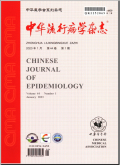活动性肺结核密切接触者发病判别模型研究
The incidence discriminant model for close contacts of active tuberculosis patients
摘要目的 建立肺结核发病判别模型,为肺结核密切接触者早期的诊断和发现提供科学依据.方法 使用logistic逐步回归分析筛选关键影响因素,采用逐步Bayes判别法对肺结核密切接触者发病的关键因素进行筛选并建立判别模型.结果 密切接触者未发病判别函数为:Y1=-39.831(常数)+1.927X1(患者痰涂片阳性次数)+3.528X2(接触者文化程度)+0.309X3(接触时间)+5.893X4(咳嗽时回避)+2.140X5(居室通风)+8.706X6(接触者咳嗽)+30.970X7(接触者发热);密切接触者发病判别函数:Y2=-57.875(常数)+2.343X1(患者痰涂片阳性次数)+3.965X2(接触者文化程度)+0.361X3(接触时间)+6.296X4(咳嗽时回避)+1.348 X5(居室通风)+12.984X6(接触者咳嗽)+36.555 X7(接触者发热).结论 模型的建立有助于肺结核密切接触的早期诊断分析,并进行早期的干预和治疗.
更多相关知识
abstractsObjective To establish a discriminant model and to provide a relatively accurate scientific basis for the early diagnosis of tuberculosis (TB) and detection of the close contacts. Methods Through logistic regression analysis, key factors were selected according to Bayes theory and key factors of TB incidence of the close contacts were screened as well as a discriminant model was established. Results The non-TB incidence discriminant function of the close contacts was described as: Y1= -39.831 (constant) + 1.927 X, (sputum-frequency) + 3.528 X2 (education) + 0.309 X3 (contact time) + 5.893 X4 (evade) + 2.140 X5 (ventilation) + 8.706 X6 (cough) + 30.970 X7 (fever). The discriminant function of non-TB incidence of the close contacts was as: Y2 =-57.875 (constant) + 2.343 X1 (sputum-frequency) + 3.965 X2 (education) + 0.361 X3 (contact time) + 6.296 X4 (evade) + 1.348 X5 (ventilation) + 12.984 X6 (cough) + 36.555 X7 (fever). Conduslon The diseriminant model night be used to contribute to the early diagnosis, early intervention and timely treatment on those close contacts of tuberculosis cases.
More相关知识
- 浏览386
- 被引2
- 下载96


相似文献
- 中文期刊
- 外文期刊
- 学位论文
- 会议论文



 换一批
换一批 换一批
换一批



